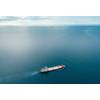Baltic Dry Index Falls for Third Consecutive Session
The Baltic Exchange's dry bulk sea freight index, which tracks rates for ships carrying dry bulk commodities, fell for a third consecutive session on Thursday, hurt by weaker rates in the capesize segment.
* The main index, which factors in rates for capesize, panamax and supramax shipping vessels, fell 13 points, or 0.8%, to 1,621 points.

* The capesize index shed 54 points, or 2.1%, to reach 2,527 points, lowest level since March 11.
* "On the West Australia front, we see relatively limited cargoes and some enquiries for slightly forward end April dates," shipbroker Fearnleys wrote in a weekly note on Wednesday referring to capesize vessel segment.
* Average daily earnings for capesize vessels, which typically transport 150,000-ton cargoes such as iron ore and coal, decreased by $445 to $20,957.
* Iron ore futures prices strengthened, buoyed by seasonal steel demand in top consumer China, outweighing trade war woes sparked by fresh U.S. tariffs.
* The panamax index added 28 points, or 1.9%, to 1,484 points, highest level since Sept. 26.
* Average daily earnings for panamax vessels, which usually carry 60,000-70,000 tons of coal or grain, gained $251 to $13,359.
* Among smaller vessels, the supramax index was down by 7 points or 0.7% at 1,007 points.
* Elsewhere, Ukraine and Russia accused one another on Wednesday of flouting a truce on energy strikes brokered by the United States, and the European Union said it would not meet conditions set by Russia for a planned ceasefire in the Black Sea.
(Reuters)
Related News


